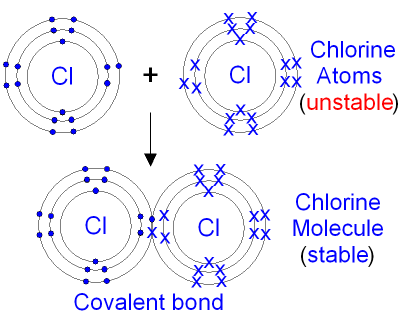gcsescience.com
25
gcsescience.com
Atomic Structure
Why does a Chlorine
Molecule have a Covalent Bond?
Chlorine is a non-metal.
A chlorine atom has 7
electrons in its
outer
shell.
Chlorine is in group 7 of the periodic table.
Two chlorine atoms will each
share one electron
to get a full
outer shell and form a stable Cl2
molecule.
This is a picture of the shared
electrons making a covalent bond
in a chlorine molecule. Chlorine is a simple molecule.

By sharing the two electrons where the shells touch
each chlorine atom can count 8
electrons in its outer shell.
These full outer
shells with their shared electrons
are now stable and the Cl2 molecule will not
react further
with other chlorine atoms.
One pair of shared electrons form a single covalent bond.
There are no ions present (no + or - charges) in chlorine
gas
because
the electrons are shared,
not
transferred from one atom to
another.
Chlorine does form hydrogen
ions
when it is dissolved
in water to become chloric
acid.
 Links
Revision Quizzes
Revision Questions
Links
Revision Quizzes
Revision Questions

gcsescience.com
The Periodic Table
Index
Covalent Bonding Quiz
gcsescience.com
Home
GCSE Chemistry
GCSE Physics
Copyright © 2015 gcsescience.com. All Rights Reserved.
